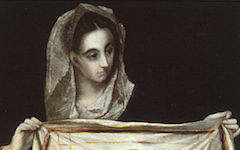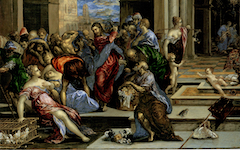El Greco’s Knight Taking an Oath (1578-80)

El Greco, Knight Taking an Oath or Knight with His Hand on His Chest (1578-80) Oil on canvas. Prado Museum, Madrid
Click image to enlarge.
Regular users of this site already know how commonly poetic painters use long, thin weapons as symbols of their similarly-shaped paintbrushes.1 They will have no trouble recognizing that the hilt of this knight's sword spells D for Domenikos Theotokopoulos, El Greco's real name. Looking into the mirror of the artist's mind (which is why the D is reversed) we find his alter ego swearing an oath to painting just as a number of other artists have done before and since. El Greco signed paintings with either his original Greek name or his initials.
Click next thumbnail to continue

Michelangelo, Detail of St. Sebastian in the Last Judgment (1536-41) Mural. Sistine Chapel, Rome
Click image to enlarge.
Thirty years earlier Michelangelo made St. Sebastian, who by now should be recognized as the self-reflective artist's iconic saint, hold a bunch of arrows like paintbrushes in the Last Judgment. As also explained in a separate entry, Sebastian holds them proudly and defiantly as symbols of Michelangelo's craft.2
Click next thumbnail to continue

Titian, Detail of Diana and Callisto (1556-59) Oil on canvas. National Gallery of Scotland
Click image to enlarge.
One of Diana's nude nymphs in Titian's Diana and Callisto sits facing the canvas like the artist would have in the lower right corner of the composition. She holds one giant arrow for the same purpose because both her pose and gender identify her as Titian's alter ego. Rona Goffen was absolutely correct in writing that Titian's women are all representations of himself.3
Click next thumbnail to continue
Jumping to the nineteenth century Edouard Manet had his son hold a giant sword (or "paintbrush") to represent through his son his own dedication to painting. (A new entry on Manet's Boy with a Sword has just been published.)
Click next thumbnail to continue

El Greco, Knight Taking an Oath or Knight with His Hand on His Chest (1578-80)
Click image to enlarge.
Like many portraits by great masters (indeed, the vast majority of them) no-one knows who El Greco's sitter originally was. It does not matter much because a poetic painter like El Greco would rarely have cared about the man's actual personality. What mattered is that the man posing as the artist's self-representation was a Spanish knight in the prime of life enjoying an honored role in Spanish society that El Greco hankered after for his art but which, as a foreigner and craftsman, he would never have been able to achieve.
The awkward position of the man's fingers may contain coded meaning but it is so common on figures by El Greco that it clearly works in part as a signature.
More Works by El Greco
Notes:
1. See examples under the theme Swords and Weapons as Paintbrushes.
2. See our entry on "Michelangelo's Saint Sebastian in the Last Judgment."
2. Goffen, Titian’s Women (New Haven: Yale University Press) 1997, pp. 8, 286
Original Publication Date on EPPH: 08 Mar 2012. | Updated: 0. © Simon Abrahams. Articles on this site are the copyright of Simon Abrahams. To use copyrighted material in print or other media for purposes beyond 'fair use', you must obtain permission from the copyright owner. Websites may link to this page without permission (please do) but may not reproduce the material on their own site without crediting Simon Abrahams and EPPH.



